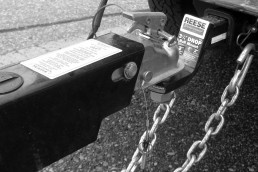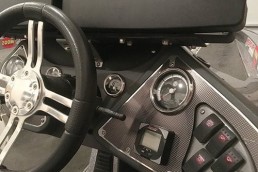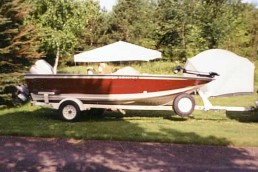Are Your Trailer Safety Chains Safe Enough?
SHARE THIS POST
Before heading out to the lake on your next adventure, Mike Schoonveld reminds us to make sure your trailer’s safety chains are safe and ready for travel.
Safety Chains
Nearly all boat trailers come with safety chains. And nearly all tow vehicles come with safety chain loops. No trailers ever pop loose from the vehicle while being towed, so the safety chains are about as necessary as wearing a helmet while playing cribbage, right?
It’s highly unlikely for anyone to get struck by lightning, but it happens often enough for people to be warned frequently about lightning’s danger and how to avoid being struck. So why aren’t there any warnings or directions about the proper use of safety chains? Is there a right or wrong way? Does something so simple need to have directions?
Of course not. Hook the darned things up anyway you wish. Hook ‘em long, with the hooks facing forward or backward, back on themselves. Run your rig with the chains crossed or uncrossed. Take one of the chains off and just use one. It won’t make a whit of difference 99.999 percent of the time since your trailer is unlikely to de-couple while you are hauling down the highway.
But what if you are the .001 percent guy who should wear a football helmet to a card game? What if your boat trailer does go loosey-goosey on the way to the lake? Are you about .001 seconds away from realizing properly adjusting and attaching your safely chains is something you shouldn’t have taken for granted? Eeeek!
Luckily, it’s not rocket science, it’s common sense, more than anything, and there are only three or four major considerations.
Considerations
First: Is the chain strong enough? The answer is probably yes, so don’t much worry about it. If it looks like a good strong chain it will likely do the job. If you are ever in a situation where there’s enough pull on the chain to break it, you are either pulling the Queen Mary, or there’s some other driving issue going on with your truck and trailer, and whether they are still chained together is probably the least of your worries.
Second: Should you hook the right chain to the right-side chain loop, or cross them, attaching the right chain to the left side of the trailer hitch and left chain on the right side? Either way, will keep the Queen Mary behind your vehicle if the coupler breaks off. However, if you cross the chains, there’s a chance it will form a sort of “catch basket” cradling your trailer’s tongue, keeping it a few inches from the pavement. That would give you maybe seven percent better control of what is happening just behind your back bumper—but seven percent is better than zero percent.
Third: Crossing your safety chains to make them a trailer tongue catcher only works if the chains are the correct length. If they are too long, you’ll be blowing sparks when dragging the trailer tongue down the highway, whether the chains are crossed or not.
On the other hand, if the chains are too short, plan on bending or breaking something when you turn too short, going either forward or backward. Have you ever checked the length of your chains? The trailer manufacturer didn’t know where on your tow vehicle the chain was going to be attached, so they just bolted on an average length.
Obviously, if the chains are dragging on the pavement when you are trailering, they are too long. If you bend or break something when turning, they are too short. They can be lengthened or shortened a variety of ways if needed.
Are you enjoying this post?
You can be among the first to get the latest info on where to go, what to use and how to use it!
Fourth: Most safety chains come with an open hook to simply hang them on the chain connector loop on the vehicle. They stay in place by a combination of magic and gravity. For people who don’t trust gravity or magic, hooks with a spring clip can be substituted. I believe as much in gravity and magic as a springy-things.
Forward or Back
Decades ago, the first time I watched my dad hook up our boat trailer, he hooked the safety chain hook to the vehicle from underneath. The opening of the hook facing to the rear. “If you hook it the other way, it will fall off,” he explained. So for the next 20 years or so, I backwards-hooked my trailers.
Then I saw a guy hook his safety hook with the opening forward. “Don’t they occasionally fall off hooked like that?” I asked.
“Never,” he said.
“Hmmm, must be magic,”.
So for the next year I hooked one side frontwards, one backwards. In the end, gravity and magic worked identically. Neither side ever came unhooked, and I put about 10,000 miles each year on my trailer. Along with about 10,000 potholes, it seems.
Now I hook them frontwards, just because it’s easier. Also, like most people, I just like to do things a bit differently than my parents.
To find your next favorite Chevy tow vehicle visit: https://www.chevydriveschicago.com
To become a MidWest Outdoors Insider Click here!
MWO
SHARE THIS POST
Did you enjoy this post?
You can be among the first to get the latest info on where to go, what to use and how to use it!
Mike Schoonveld
A passion for hunting, fishing, trapping and an outdoor lifestyle has been true north on Mike Schoonveld’s compass his whole life. One of the Midwest’s most prolific outdoor communicators, scores of his columns have been published in the pages of MidWest Outdoors since the first one appeared in 1987.



